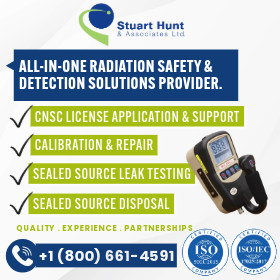Your Teeth Can Reveal How Much Radiation You’ve Been Exposed To

Note: This article was originally published in Healthy Debate. Republished under the Creative Commons licence with minor revisions approved by the author.
The world is experiencing a nuclear renaissance, and Canada is no exception. There is increasing concern among radiation professionals about potential health and environmental hazards.
Canada’s aging nuclear power plants are being refurbished, medical isotope production is on the rise, and long-term nuclear waste strategies are unfolding. In addition, the Government of Canada is promoting—and spending millions of dollars to support—the development of small nuclear reactors (SMRs) as part of a broader green energy policy.
In March 2023, the Canadian Nuclear Safety Commission (CNSC) conducted a pre-licensing review of GE Hitachi Nuclear Energy’s BWRX-300 SMR and “did not identify any fundamental barriers to licensing. However, the review did reveal some technical areas that need further development in order for GEH to better demonstrate adherence to CNSC requirements.”[1]
SMR pilot sites are well on their way to becoming a reality. This raises the bar for governments, the nuclear industry, and nuclear regulators to not only reassure but also demonstrate that the public is safe from long-term and accidental radiation exposure.
Radiation doses for those living next to Canadian nuclear power plants is estimated based on radiation monitor readings and air, water, soil, and vegetation readings. Radiation data is collected as part of CNSC’s regular monitoring program and through its Independent Environmental Monitoring Program.
However, this information assumes that everyone receives the average radiation dose. Being able to measure radiation dose at the individual level is a powerful tool to inform, educate, and reassure people about the risk of living next to a nuclear power plant.
It turns out that radiation causes stable chemical changes in tooth enamel, bones, and fingernails. These chemical changes can be used to estimate lifelong radiation exposure (also called retrospective dose estimation).[2]
Unlike bones and fingernails, which undergo continual turnover and remodeling, tooth enamel remains stable throughout a person’s life. Tooth enamel is made up of carbonated hydroxyapatite, and radiation exposure to the enamel results in the cumulative production of molecules with unpaired electrons (free radicals, namely CO2). Electron paramagnetic resonance (EPR) spectroscopy can measure free radical concentrations in extracted teeth or, hopefully soon, in the teeth still in your mouth.[3]
ERP was first used to estimate radiation dose to human tissues in 1955.[4] It has since been used to estimate doses in humans who were victims of nuclear incidents, such as Japanese atomic bomb survivors,[5] those living near or working in the former Soviet Mayak nuclear power plant that released large amounts of radioactive material into the environment,[6] and Chernobyl clean-up workers.[7]
More recently, EPR was used after the 2012 incident in which a Peruvian worker was exposed to an unshielded portable radiation source while taking X-ray pictures to assess the quality of welding in metal pipes.[8]
For the first time, researchers used EPR to measure lifelong radiation exposure in those living close to Canadian nuclear power plants.
In 2021, for the first time, researchers used EPR to measure lifelong radiation exposure in residents living close to Canadian nuclear power plants. The results were published in March 2023 in the Health Physics journal by Lekhnath Ghimire, a postdoctoral student, and Edward Waller, faculty member at Ontario Tech University in Oshawa, ON.[9] Ghimire and Waller partnered with local dentists to collect the teeth of permanent residents of Ontario’s Durham region, which has two operating nuclear power plants—Pickering and Darlington. After receiving ethics approval and informed consent, the scientists collected 64 extracted teeth from dental patients aged 16 to 69 years old and analyzed them using EPR spectroscopy.
Radiation dose is measured in Sieverts (Sv) and usually reported in units of 0.001 Sv or mSv. According to the authors, background radiation in the Durham region is about 1.3 mSv per year and the EPR results found the average dose to residents to be about 2.0 mSv per year. They hypothesize that the difference between background and measured dose is a result of a combination of medical sources (X-ray, CT, nuclear medicine, radiation therapy) and the nuclear power plants. CNSC estimates that the yearly radiation dose to the people living close to these nuclear power plants is about 0.001 mSv or less. This is 1,000 times less than the maximum public dose limit of 1 mSv.
Communicating the risks of chronic low-dose radiation to the public is challenging.[10] Radiation is invisible, exposure is involuntary, the risks at low doses are uncertain, and large-scale nuclear accidents (such as Chernobyl and Fukushima) can create fear and dread. Any strategy that can close the gap between the public’s risk perception and actual risk should be strongly entertained by nuclear industries, regulators, and the Canadian government.
Health Canada’s Radiation Protection Bureau provides expertise in assessing radiation doses, especially after radiation incidents. Although EPR is not a tool Health Canada currently uses, the research by Ghimire and Waller demonstrates that EPR may be a valuable additional tool to assess radiation risks in the general population.
Future EPR surveys that take into account medical imaging would provide direct evidence of how much radiation individuals living around nuclear facilities are receiving.
Although this added information will not satisfy everyone, especially those who ideologically oppose “all things nuclear,” it may reassure many; reassurance and “buy in” are essential in preparing Canadians for our rapidly evolving nuclear renaissance.
[1] BWRX-300 completes phases 1 & 2 of Canadian pre-licensing review. (2023, March 15). World Nuclear News. Retrieved from https://world-nuclear-news.org/Articles/BWRX-300-completes-Phases-1-2-of-Canadian-pre-lice.
[2] Fattibene, P., et al. (2023). Reflections on the future developments of research in retrospective physical dosimetry. Physics Open, 14, 100132. https://doi.org/10.1016/j.physo.2022.100132
[3] Fattibene, P., & Callens, F. (2010). EPR dosimetry with Tooth Enamel: A Review. Applied Radiation and Isotopes, 68(11), 2033–2116. https://doi.org/10.1016/j.apradiso.2010.05.016
[4] Gordy, W., Ard, W. B., & Shields, H. (1955). Microwave spectroscopy of biological substances. I. Paramagnetic resonance in x-irradiated amino acids and proteins. Proceedings of the National Academy of Sciences, 41(11), 983–996. https://doi.org/10.1073/pnas.41.11.983
[5] Ikeya, M., Miyajima, J., & Okajima, S. (1984). ESR dosimetry for atomic bomb survivors using shell buttons and tooth enamel. Japanese Journal of Applied Physics, 23(9A). https://doi.org/10.1143/jjap.23.l697
[6] Degteva, M.O., et al. (2015). Analysis of EPR and FISH studies of radiation doses in persons who lived in the upper reaches of the Techa River. Radiat Environ Biophys, 54, 433–444. https://doi.org/10.1007/s00411-015-0611-8
[7] Chumak, V., Sholom, S., & Pasalskaya, L. (1999). Application of high precision EPR dosimetry with teeth for reconstruction of doses to Chernobyl populations. Radiation Protection Dosimetry, 84(1), 515–520. https://doi.org/10.1093/oxfordjournals.rpd.a032790
[8] International Atomic Energy Agency (2018). The radiological accident in Chilca, Non-serial publications. https://www.iaea.org/publications/11095/the-radiological-accident-in-chilca
[9] Ghimire, L., & Waller, E. (2022). Electron paramagnetic resonance measurements of lifetime doses in teeth of Durham Region residents, Ontario. Health Physics, 124(3), 175–191. https://doi.org/10.1097/hp.0000000000001650
[10] International Atomic Energy Agency. (2016). Communicating with the public and other interested parties. IAEA. https://www.iaea.org/topics/communicating-with-stakeholders-and-the-public

Healthy Debate publishes journalism (clear, captivating op-eds and feature reports) about health care in Canada by the people whose lives it touches the most—from physicians, patients, and caregivers to health journalists, academics, and advocates. Their unique focus on giving a platform to health-care insiders allows them to provide detailed coverage of the inner workings—and dysfunctions—of this important sphere of Canadian society. They are a forum where the public can learn about, discuss, and debate health care in Canada and, importantly, imagine what it could become.
 Dr. Sandor Demeter
Dr. Sandor Demeter
Sandor is a nuclear medicine and public health physician and associate professor in the Department of Community Health Sciences at the University of Manitoba. He served two terms as a commission member with the Canadian Nuclear Safety Commission (CNSC), as well as two terms as a member of the International Commission on Radiological Protection (ICRP) Committee 3 (Medicine). He is a member of the Canadian Agency for Drugs and Technologies in Health (CADTH) Health Technology Expert Review Panel.
Sandor recently completed a Fellowship in Global Journalism at the Dalla Lana School of Public Health, University of Toronto.
Do you want to read more articles like this?
The Bulletin is published by the Canadian Radiation Protection Association (CRPA). It’s a must-read publication for radiation protection professionals in Canada. The editorial content delivers the insights, information, advice, and valuable solutions that radiation protection professionals need to stay at the forefront of their profession.
Sign up today and we’ll send you an email each time a new edition goes live. In between issues, check back often for updates and new articles.
Don’t miss an issue. Subscribe now!
Subscribe

 Dr. Sandor Demeter
Dr. Sandor Demeter

